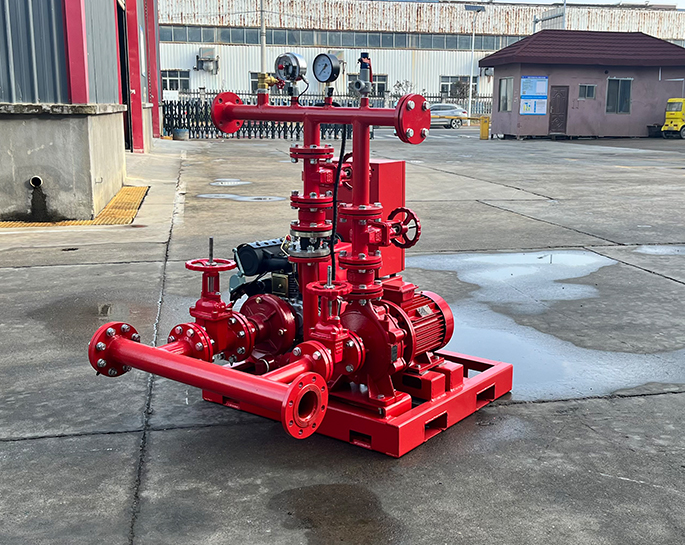What are some best practices for optimizing the performance and longevity of firefighting pumps?
Feb 23, 2024
Share:
Optimizing the performance and longevity of firefighting pumps is crucial for ensuring they function effectively when needed. Here are some best practices:
1. **Regular Maintenance:** Implement a regular maintenance schedule for the pump according to the manufacturer's recommendations. This includes checking fluid levels, inspecting for leaks, and ensuring proper lubrication.
2. **Training:** Ensure that personnel responsible for operating and maintaining the firefighting pump are adequately trained. Proper training can help prevent misuse or damage to the equipment.
3. **Keep Clean:** Keep the pump and its surrounding area clean from debris, dirt, and other contaminants. Regularly inspect and clean the intake strainers and filters to prevent clogs.
4. **Monitor Performance:** Regularly test the pump to ensure it is performing at its optimal capacity. This can involve flow testing, pressure testing, and checking for any unusual noises or vibrations.
5. **Temperature Management:** Avoid running the pump for extended periods at high temperatures, as this can lead to overheating and premature wear. Ensure proper ventilation and cooling mechanisms are in place.
6. **Proper Storage:** Store the firefighting pump in a clean, dry, and well-ventilated area when not in use. Protect it from extreme temperatures, moisture, and other environmental factors that could cause corrosion or damage.
7. **Replace Worn Parts:** Keep an eye on the condition of pump components and replace any worn or damaged parts promptly. This includes seals, gaskets, hoses, and fittings.
8. **Inspect and Maintain Seals:** Check seals and gaskets regularly for signs of wear or deterioration. Replace them as needed to prevent leaks and ensure proper sealing.
9. **Monitor Fuel Quality:** If the pump is powered by a fuel engine, ensure that the fuel used is clean and of high quality. Contaminated or stale fuel can cause engine problems and reduce performance.
10. **Emergency Shutdown Procedures:** Establish and train personnel on emergency shutdown procedures in case of pump malfunction or other emergencies to prevent further damage.
11. **Follow Manufacturer's Guidelines:** Adhere strictly to the manufacturer's guidelines and recommendations for operation, maintenance, and storage of the firefighting pump.
By following these best practices, you can help optimize the performance and longevity of firefighting pumps, ensuring they are ready to respond effectively in emergency situations.

1. **Regular Maintenance:** Implement a regular maintenance schedule for the pump according to the manufacturer's recommendations. This includes checking fluid levels, inspecting for leaks, and ensuring proper lubrication.
2. **Training:** Ensure that personnel responsible for operating and maintaining the firefighting pump are adequately trained. Proper training can help prevent misuse or damage to the equipment.
3. **Keep Clean:** Keep the pump and its surrounding area clean from debris, dirt, and other contaminants. Regularly inspect and clean the intake strainers and filters to prevent clogs.
4. **Monitor Performance:** Regularly test the pump to ensure it is performing at its optimal capacity. This can involve flow testing, pressure testing, and checking for any unusual noises or vibrations.
5. **Temperature Management:** Avoid running the pump for extended periods at high temperatures, as this can lead to overheating and premature wear. Ensure proper ventilation and cooling mechanisms are in place.
6. **Proper Storage:** Store the firefighting pump in a clean, dry, and well-ventilated area when not in use. Protect it from extreme temperatures, moisture, and other environmental factors that could cause corrosion or damage.
7. **Replace Worn Parts:** Keep an eye on the condition of pump components and replace any worn or damaged parts promptly. This includes seals, gaskets, hoses, and fittings.
8. **Inspect and Maintain Seals:** Check seals and gaskets regularly for signs of wear or deterioration. Replace them as needed to prevent leaks and ensure proper sealing.
9. **Monitor Fuel Quality:** If the pump is powered by a fuel engine, ensure that the fuel used is clean and of high quality. Contaminated or stale fuel can cause engine problems and reduce performance.
10. **Emergency Shutdown Procedures:** Establish and train personnel on emergency shutdown procedures in case of pump malfunction or other emergencies to prevent further damage.
11. **Follow Manufacturer's Guidelines:** Adhere strictly to the manufacturer's guidelines and recommendations for operation, maintenance, and storage of the firefighting pump.
By following these best practices, you can help optimize the performance and longevity of firefighting pumps, ensuring they are ready to respond effectively in emergency situations.


.png)
.png)

.png)


